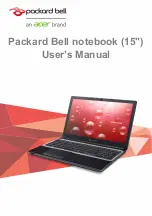
- 104 -
Digital Video and IEEE 1394 Devices
Your NEC VERSA may feature a mini-IEEE 1394 port. The IEEE 1394 is also called FireWire
®
or i-link® on
some electronic devices.
The notebook may also feature a software application specially designed to easily capture video from digital
video cameras, PC cameras, and other sources.
IEEE 1394 Devices
What are the benefits of the IEEE 1394 port?
The IEEE 1394 multimedia connection enables simple, low-cost, high-bandwidth isochronous (real-time)
data interfacing between computers, peripherals, and consumer electronics products such as camcorders,
VCRs, printers, PCs, TVs, and digital cameras. With IEEE 1394-compatible products and systems, users can
transfer video or still images from a camera or digital video camera to a printer, PC, or television, with no
image degradation.
During the analogue days, connecting a TV to a VCR, or playing back a movie from your camcorder to your
TV was fairly easy. Then came the digital revolution. Historically, connecting digital devices together -
especially high-speed devices- often meant special requirements, including software settings, device IDs,
jumpers, switches, screws, latches and terminators. The IEEE 1394 standard works just like in the old
analogue days; you plug in a cable and it works.
The IEEE 1394 standard defines its interface as:
•
Digital
- requires no conversion of digital data into analogue, implying better signal integrity.
•
Hot
plug - allows a device to be added and removed without turning off or rebooting the system.
•
Scalable
- supports multiple speeds.
•
Fast
- supports guaranteed delivery of time critical data, thus enabling high-quality audio and video
applications.
Digital Video
What is the Digital Video (DV) format?
Digital Video is the preferred file format for high quality video, usually captured via a digital video camera. It
is a super high-resolution format that exceeds the quality of S-VHS. The images are crisp, bright and have
excellent depth and contrast. The information is stored on the video tape in digital form, so it can be copied
over and over without any loss.
The DV standard defines all aspects of the so called "DV" or Digital Video camcorders, including tape
recording format and form factor, video compression algorithms and also digital data transmissions.
What are the benefits of Digital Video?
A digital video camera actually puts professional video capabilities into the hands of just about everyone.
Transferring your video to your PC is made extremely simple, as is the actual editing of the video, thanks to
specific software applications.

































